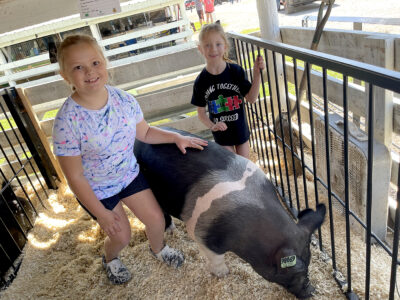Something fishy
Fish barrier installation at Brushy Creek to prevent flood losses
-
-Submitted photo
Doyle Construction workers pour concrete of the new fish barrier being installed at Brushy Creek Lake Tuesday.
-
-Submitted photo
Doyle Construction poured the concrete foundation for the fish barrier being installed at Brushy Creek Lake’s spillover. The barrier will help reduce substantial Walleye and Muskellunge losses during flooding events, particularly in the spring.
-
-Messenger photo by Elijah Decious
A look at the fish barrier in progress at Brushy Creek Lake, which passes under the main traffic artery that leads through the State Recreation Area.
-
-Submitted photo
This completed fish barrier at Big Creek in Boone County shows what the one being installed at Brushy Creek State Recreation Area will look like in about a week.

-Submitted photo
Doyle Construction workers pour concrete of the new fish barrier being installed at Brushy Creek Lake Tuesday.
DUNCOMBE — The installation of a fish barrier at Brushy Creek State Recreation Area is going swimmingly.
The new concrete and fence apparatus at Brushy Creek Lake’s spillover, sponsored by the Iowa Department of Natural Resources and constructed this week, will prevent significant losses of walleye and muskellunge during flood events, particularly in the spring.
A study with the DNR, Iowa State University and the U.S. Army Corps of Engineers showed losses over the last five years at the park’s spillway and the spillway at Big Creek Lake in Boone County. A fish barrier installed at the latter in 2012 has proven effective at reducing losses, the DNR says.
While Brushy Creek Lake loses about 20% of its walleye and 50% of its adult muskellunge fish population during flood events, Big Creek Lake losses have been eliminated.
Ben Dodd, DNR fisheries biologist, said the same results are expected at Brushy Creek after installation is complete later next week.

-Submitted photo
Doyle Construction poured the concrete foundation for the fish barrier being installed at Brushy Creek Lake’s spillover. The barrier will help reduce substantial Walleye and Muskellunge losses during flooding events, particularly in the spring.
“What we’re finding is that the majority of fish loss occurs in the spring when walleye and muskellunge are going through spawning motions,” Dodd said. “They come into shallow water, and the time frame coincides with big flood and rain events.”
The losses typically come with an extra six to 12 inches of water going over the spillway, he said. The lake is prone to the extra water in the spring.
As water levels rise, fish spawning in shallow waters are swept up by the current to their death. That understanding isn’t a “revolutionary idea,” Dodd said, as the DNR started noticing significant muskellunge losses about 10 years ago.
But the simple solution — a fence mounted over a concrete-filled trench short of the spillway’s edge — has significant effects for not only the fish, but the people they draw to state recreation areas.
“We’re trying to maintain a predator density that’s going to provide enjoyable opportunities for anglers without causing major impacts to the rest of the fishery,” Dodd said.

-Messenger photo by Elijah Decious
A look at the fish barrier in progress at Brushy Creek Lake, which passes under the main traffic artery that leads through the State Recreation Area.
By keeping adult walleye and muskellunge in the reservoir, the key predator population is large enough to satisfy fishers. The DNR also has to strike a balance in managing the population to ensure they don’t impact other fish breeds in lakes, like bluegills and crappies.
And by reducing fish loss in lakes, the DNR can reduce annual restockings, lowering state hatchery production costs. Brushy Creek Lake is stocked with 1.5 million walleye fry, and over 3,700 walleye fingerlings every year.
Doyle Construction, of Fort Dodge, started constructing the barrier last week and poured concrete on Tuesday. Fence installation is expected to be complete by the end of next week, according to contractor Jason Doyle.
The lake’s water level will remain lowered by about 4 feet for the next month, according to the DNR. The west ramp of the lake will still be usable, even with lowered levels. The public will not be allowed on the spillway during construction due to increased current around the intake and operation of heavy equipment.

-Submitted photo
This completed fish barrier at Big Creek in Boone County shows what the one being installed at Brushy Creek State Recreation Area will look like in about a week.








